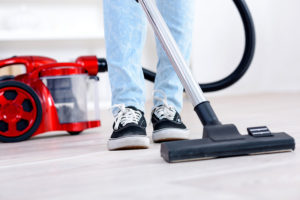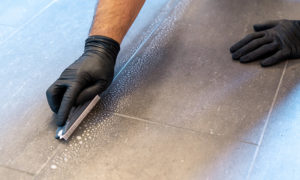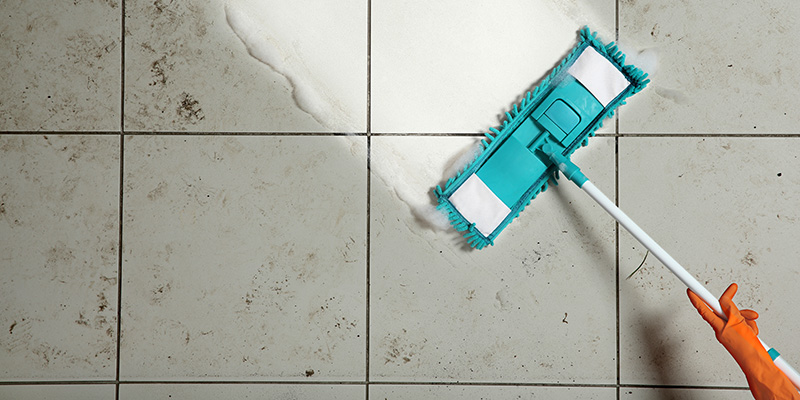Tile floors are not the easiest surfaces to clean due to the many types of materials they can be made with. If you want to learn how to properly clean tile floors without damaging them, you have come to the right place.
How to Clean Tile Floors Properly
Whether residential or commercial, tile floors have become a popular choice. They’re great for aesthetics and very durable, too. However, cleaning tile floors is not always a simple task. The process differs from cleaning other types of flooring. In many ways, it can be a source of annoyance.
Without proper knowledge of tile cleaning, you can damage your tile floors. This will ultimately lead you to incur more expenses. Before you start scrubbing away, you must first learn how to clean tile floors according to the material they are made of.
How to Clean Ceramic and Porcelain Tile Floors

Tile floors can be made with a variety of materials, but perhaps the most common are ceramic and porcelain.
Though they do have their differences, ceramic and porcelain tiles are popular choices because they are both beautiful to look at and easy to maintain. In fact, you can use just about any type of cleaner on these tiles without risking damage or stripping away the shine.
What is the best cleaning solution for ceramic tile floors? You don’t need a professional tile floor cleaning machine. The process on how to clean ceramic tile is the same as the process on how to clean porcelain tile floors, seen below:
- The first step is to get rid of all the loose dirt, dust, and debris. You can do this with the help of a broom, vacuum cleaner, or microfiber duster. Make sure you clean the corners, too, as those tend to be overlooked.
- Take your cleaner of choice and mix it with warm water. You can opt for an all-purpose cleaner, dish soap, or even just plain.
- Take a rag or mop and dip it into the water and cleaner mixture. Make sure to squeeze out the excess liquid.
- Note: Do not use a sponge mop as that will make it harder to clean the grout lines.
- Clean the tile floor with a damp mop or rag. Use even strokes, making sure to cover the entire area.
- Rinse the rag or mop as it gets dirty.
- The water and cleaner mixture will get cloudier after every rinse. Replace the solution regularly to keep a murky film of filth from forming on the tiles.
- Note: If you do leave a film on the tiles, use a damp rag dipped in a solution of hot water and white vinegar to wipe the film away.
- Finally, take a clean, dry cloth or mop and wipe away the excess moisture from the tile floors. This helps avoid water spots from forming.
How to Clean Marble and Stone Tile Floors
Marble and stone tile floors definitely add a certain charm to any bathroom or kitchen, but they can be high-maintenance. You can take the same cleaning approach on marble and stone tiles as you would on porcelain and ceramic tiles. But, you will need to change your cleaning supplies and solutions.
What is the best tile floor cleaner solution for marble and stone? Traditional cleaners tend to contain harsh chemicals that can cause damage to natural stone and marble. Tailor your cleaner according to the tile floor:
- Marble Tile – For marble tiles, go for a mild tile floor cleaner with no acidic content. Avoid using vinegar and lemon on marble as the acid can etch the tile’s surface. Additionally, stay away from scouring powders. When cleaning marble tiles, use a brush or broom with soft bristles to avoid scratches.
- Slate Tile – Slate tiles are similar to marble tiles in that they cannot handle anything acidic, so vinegar and lemon are off-limits. Instead, use a mild detergent with no acidic content. It is also best to use a soft-bristled broom or brush to avoid etching the surface of your slate tile. Finally, make sure to dry the tile immediately after washing to prevent water spots from forming.
- Granite Tile – Granite tiles are prone to discoloration, so make sure to use a pH-neutral mild detergent to avoid this problem. In addition to discoloration, harsh cleaners can leave unnatural streaks on granite tile surfaces. Just like with slate and marble tiles, use a broom or brush with soft bristles to clean granite tiles. Consider buffing the surface to maintain its sheen.
How to Clean Vinyl and Linoleum Tile Floors
Vinyl and linoleum are cheaper alternatives to ceramic and stone tiles, which is why they are also popular choices for bathrooms and kitchens. When it comes to resilient floorings like vinyl, linoleum, and cork, though, it is important to remember that extreme heat and excess moisture can damage them. As such, stay away from steam mops.
Here is the best way to clean tile floors made of vinyl, linoleum, or cork:
- Vinyl Tile – Sweep or vacuum any loose dirt, dust, and debris from the vinyl surface. Then, take a mop dampened with a vinyl-safe cleaner. Ask your vinyl tile manufacturer for the best cleaner to use. Alternatively, a water and vinegar mixture can also work. Do not use an abrasive cleaner or coarse brush on vinyl tiles as these can leave scratch marks.
- Linoleum Tile – To start, sweep the area to remove any loose dirt, dust, and debris. Clean the linoleum tiles using a manufacturer-recommended or linoleum-safe cleaning solution. You can also use a combination of water and Borax. Rinse away any excess cleaning solution before drying the linoleum surface.
- Note: To keep your linoleum flooring in good shape, apply a coat of wax (liquid or solid) and buff the surface to maintain its shine. Do this every 3 to 6 months.
- Cork Tile – The best way to clean cork flooring depends on the finish of the tile surface. Most cork floors have a polyurethane finish, which calls for a mixture of water and mild detergent or water and white vinegar. For unfinished or waxed cork flooring, use the same cleaning solution as cork floors sealed with polyurethane. This time, though, make sure to apply a coat of wax (liquid or solid) after the tile has dried.
How to Clean Grout on Tile Floors
 It is easy enough to clean the surface of tile floors, but grout lines are another thing. Grout can stain quickly, especially if the grout’s color is lighter.
It is easy enough to clean the surface of tile floors, but grout lines are another thing. Grout can stain quickly, especially if the grout’s color is lighter.
To clean grout, you can use a grout cleaner or a bleach solution. Apply the cleaner or solution on grout lines before rinsing it off. When working with bleach, make sure to wear gloves at all times.
If grout cleaners or a bleach solution does not work, use a homemade tile floor cleaner. Simply combine baking soda with water to create a paste. Apply the paste to the stains in your grout lines and allow it to set. You can leave it for a few hours or up to overnight. Then, using a tile floor scrubber (nylon brush or spare toothbrush), scrub the stain and rinse it off.
Do not use a steam cleaner to clean your grout lines. Steam cleaners are great for deep cleaning a lot of other things, but they can cause damage to grout in the long run. Therefore, if you want to deep clean tile floors, stay away from these machines.
When to Clean Tile Floors
You must sweep or vacuum tile floors at least twice a week to remove any loose dirt, dust, and debris. Remember that these types of filth can affect the shine of your tiles, so it is important to make it a part of your regular cleaning schedule.
As for wet cleaning, i.e. using a mop and cleaning solution, it depends on where your tile floors are located. Bathroom tiles should be cleaned once every week, while kitchen tiles should be cleaned once every two weeks. For grout cleaning, do it once every 2 to 3 months.
Tile Cleaning Made Easy
It is imperative to clean tile floors regularly. In doing so, you can maintain their appearance and quality, thereby avoiding damages and potential costs associated with those damages.
If your tile floors have gone months or years without cleaning, they might suffer from a build-up of filth. Cleaning tiles in this condition usually calls for professional help. Call Maintenance Specialists Inc. at (704) 405-6000 or contact us online for more information.
RELATED ARTICLES:

